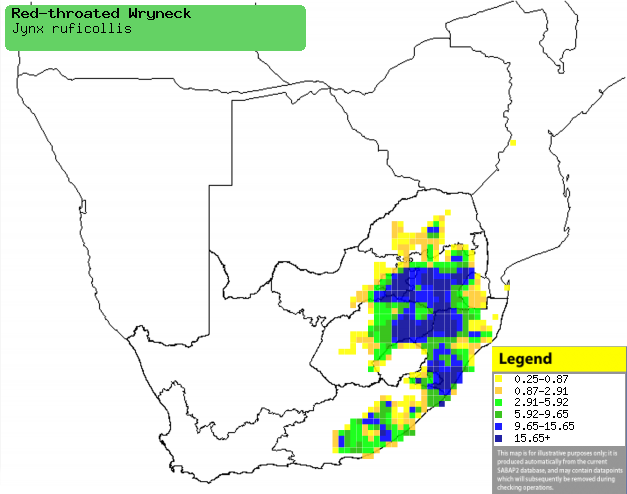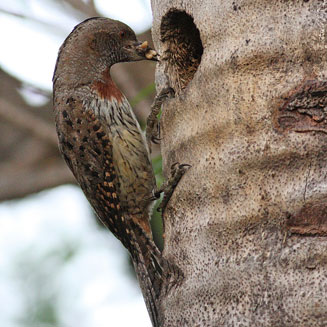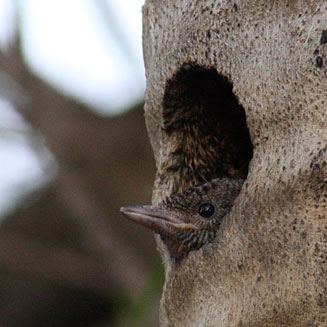|
Jynx ruficollis (Red-throated
wryneck)
Draaihals [Afrikaans]; Kolutsoku [South Sotho]; Afrikaanse
draaihals rufous-necked [Dutch]; Torcol à gorge rousse [French];
Braunkehl-wendehals, Rotkehl-wendehals [German]; Torcicolo-de-garganta-castanha
[Portuguese]
Life
> Eukaryotes >
Opisthokonta
> Metazoa (animals) >
Bilateria >
Deuterostomia > Chordata >
Craniata > Vertebrata (vertebrates) > Gnathostomata (jawed
vertebrates) > Teleostomi (teleost fish) > Osteichthyes (bony fish) > Class:
Sarcopterygii (lobe-finned
fish) > Stegocephalia (terrestrial
vertebrates) > Tetrapoda
(four-legged vertebrates) > Reptiliomorpha > Amniota >
Reptilia (reptiles) >
Romeriida > Diapsida > Archosauromorpha > Archosauria >
Dinosauria
(dinosaurs) > Saurischia > Theropoda (bipedal predatory dinosaurs) >
Coelurosauria > Maniraptora > Aves
(birds) >
Order: Piciformes
> Family: Picidae
The Red-throated wryneck has populations scattered across
sub-Saharan Africa, including one confined to South Africa and Swaziland. It is
highly specialized, living only in grassland and feeding exclusively on ants
and termites. It usually nests in tree cavities made by other birds, but it also
can use natural tree holes and nest boxes. It lays 16, usually 3-4 eggs, which
are incubated by both sexes for about 13 days. The chicks are cared for by both
parents, staying in the nest for about 25-26 days. The juveniles become
independent soon after fledging.
Distribution and habitat
It has populations scattered across sub-Saharan Africa,
including one confined to South Africa and Swaziland. Within southern Africa it
occurs from the Limpopo Province to the Eastern Cape, generally preferring
grassland with sparse trees.
|
 |
|
Distribution of red-throated wryneck in southern
Africa, based on statistical smoothing of the records from first SA Bird
Atlas Project (©
Animal Demography unit, University of
Cape Town; smoothing by Birgit Erni and Francesca Little). Colours range
from dark blue (most common) through to yellow (least common).
See here for the latest distribution
from the SABAP2. |
Brood parasites
It has been recorded as host of the
Lesser honeyguide.
Food
Highly specialized, as it feeds
exclusively on ants and termites. It often excavates ant nests, licking them up
with its sticky tongue. The following insects have been recorded in its diet:
- Insects
- ants, their eggs and pupae (Formicidae)
- Pheidole megacephala
- Crematogaster castanea
- Lepisiota capensis
- Acantholepis capensis
- Tetramorium setulferum
-
termites
Breeding
- It usually nests in tree cavities made by other bird
species, especially woodpeckers and barbets (incl.
Lybius torquatus (Black-collared
barbet) and Trachyphonus vaillantii (Crested
barbet). It also nests in natural tree cavities, nest boxes and hollow metal
fence posts.
 |
 |
| Red-throated wryneck at its nest hollow
with pupae, Standerton, Mpumalanga, South Africa. [photo
Johan van
Rensburg ©] |
Red-throated wryneck chick, Standerton, Mpumalanga, South Africa. [photo
Johan van
Rensburg ©] |
- Egg-laying season is from August-February, peaking in October.
- It lays 1-6, usually 3-4 eggs, which are incubated by both sexes for
about 13 days.
- The chicks are cared for by both parents, staying in the nest for about
25-26 days. If threatened, an older chick will perform a threat display
similar to a striking snake, extending its neck forward then rapidly
recoiling. The juveniles become independent soon after fledging.
Threats
Not threatened.
References
-
Hockey PAR, Dean WRJ and Ryan PG (eds) 2005. Roberts -
Birds of southern Africa, VIIth ed. The Trustees of the John Voelcker
Bird Book Fund, Cape Town.
|
